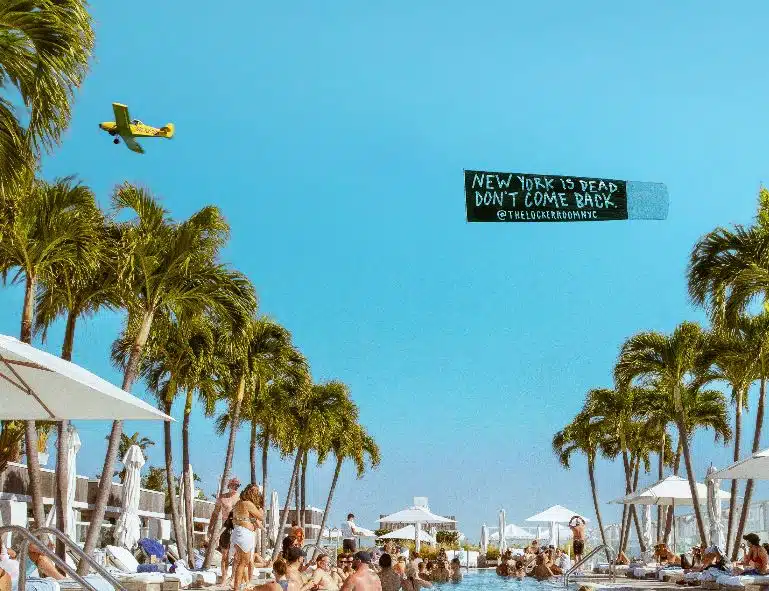Aerial Advertising: A Guide to Airplane Banners, Skywriting, Drones and More
Aerial advertising encompasses any type of marketing taking place in the sky. Airplanes towing banners, skywriting, drones and even flogos are forms of aerial advertising.
Aerial advertising encompasses any type of marketing that happens in the sky — from airplanes towing banners to drones, blimps, skywriting, and even floating foam logos (“flogos”). It’s a standout choice for brands that want to cut through cluttered advertising channels and grab attention in a bold, unexpected way.Aerial advertising dates back to the early 20th century. Its long-standing appeal lies in its simplicity, visibility, and novelty. While newer forms like drone light shows are gaining popularity, even classic banner towing remains highly effective — especially when deployed in the right environment.Although it’s a smaller slice of the outdoor advertising world, aerial media still punches above its weight when it comes to impressions and memorability. That’s why advertisers keep coming back — from beach campaigns and sporting events to Coachella flyovers and surprise proposals.This guide covers everything from costs and formats to weather considerations and high-performing ad types.
Airplane Banner Towing Cost
Banner towing remains one of the most affordable and accessible aerial ad options — often cheaper than a billboard in major markets like NYC or LA. Pricing typically starts at $7,000 to $9,000 for a single-day campaign, with a 2-hour flight minimum. This includes:- Ferry fees: Flying the aircraft to the target location
- Flight time: The duration of your message in the sky
- Banner creation: Your logo, tagline, or full billboard-style message
- Logo boards: A simple, cost-effective banner with your name and a short message
- Aerial billboards: Larger, colorful designs that mimic traditional billboards
What Type of Ads Work for Airplane Banners?
The best airplane banners are short, bold, and easy to read. Think of them as a flying tweet: short headline, simple logo, clear call-to-action. Text-only banners are the most popular, but some campaigns now include LED-lit boards or illuminated messages for nighttime exposure — though these cost more due to power needs and special permits.
Weather Restrictions for Skywriting
Skywriting is eye-catching and shareable — but weather-sensitive. It requires clear skies, low wind, and moderate humidity to be effective. If visibility isn’t ideal, messages may blur quickly or disappear before they land.For more control and reliability, advertisers can explore skytyping (a series of planes printing large-scale messages in dot matrix format) or pivot to drone formations that operate in more variable conditions.How Much Does Skywriting Cost?
Skywriting starts around $4,000 to $5,000 for a one-time message — making it more affordable than other aerial formats. Pricing includes ferry fees, pilot costs, and message rendering in the sky.Messages typically last 5–10 minutes depending on weather. They’re great for proposals, local promotions, or event launches.Want nighttime impact? Laser projection is gaining popularity. Brands can project text or animations onto clouds or buildings — perfect for city takeovers.The Ins and Outs of Flogos

The New Kid: Drone Advertising
Drone ads are evolving fast. What began as flying banners has transformed into highly choreographed light shows that form brand logos, symbols, or text in midair. With 200+ drones working in sync, these displays are as much performance as advertisement.Used at events like the Super Bowl, Coachella, and brand launches, drone shows dominate social media — driving earned impressions long after the event ends.Bonus: some setups allow for giveaway drops (coupons, samples) from low-hovering drones — a new twist on street team marketing.Best Places to Fly Aerial Ads
To make aerial advertising work, go where the people are. The best environments include:- Beaches: High foot traffic, open skies, and minimal distractions make coastal areas ideal — especially summer weekends.
- Music Festivals: Perfect for drone shows, helicopter flyovers, and creative messaging. Think Lollapalooza, Burning Man, ACL.
- Sporting Events: Super Bowl, college bowl games, and Formula 1 races are gold mines for attention.
- Theme Parks or Tourist Areas: Catch relaxed audiences who are more receptive to memorable branding moments.
- City Centers: Big metro areas like NYC, LA, Miami, and Vegas offer large, diverse audiences and maximize ROI.
Top Cities for Aerial Advertising
Aerial advertising is most effective in areas with high foot traffic, major events, or open beachlines. Below are some of the top-performing U.S. markets where brands regularly launch airplane banner and skywriting campaigns:
- Los Angeles, CA: Venice Beach, Santa Monica Pier, and packed freeways make it ideal for sky ads and banner flights.
- Miami, FL: South Beach, Art Basel, and Spring Break draw huge beachfront crowds year-round.
- New York City, NY: Jones Beach, Long Island beaches, and event flyovers along the coast.
- Las Vegas, NV: High-visibility flights over the Strip during festivals, conventions, and nightlife hours.
- Austin, TX: SXSW and ACL music festivals make Austin a prime target for aerial campaigns over downtown crowds.
- Chicago, IL: Lakefront parks, Navy Pier, and festival weekends bring heavy seasonal foot traffic.
Aerial Advertising Formats Compared
| Format | Best For | Estimated Cost |
|---|---|---|
| Banner Tow | Beaches, festivals, freeway corridors | $1,500 – $15,000+ |
| Skywriting | Short messages, marriage proposals, quick bursts | $3,000 – $10,000 |
| LED Aircraft | Nighttime events, conventions, branded flights | $5,000 – $25,000+ |
